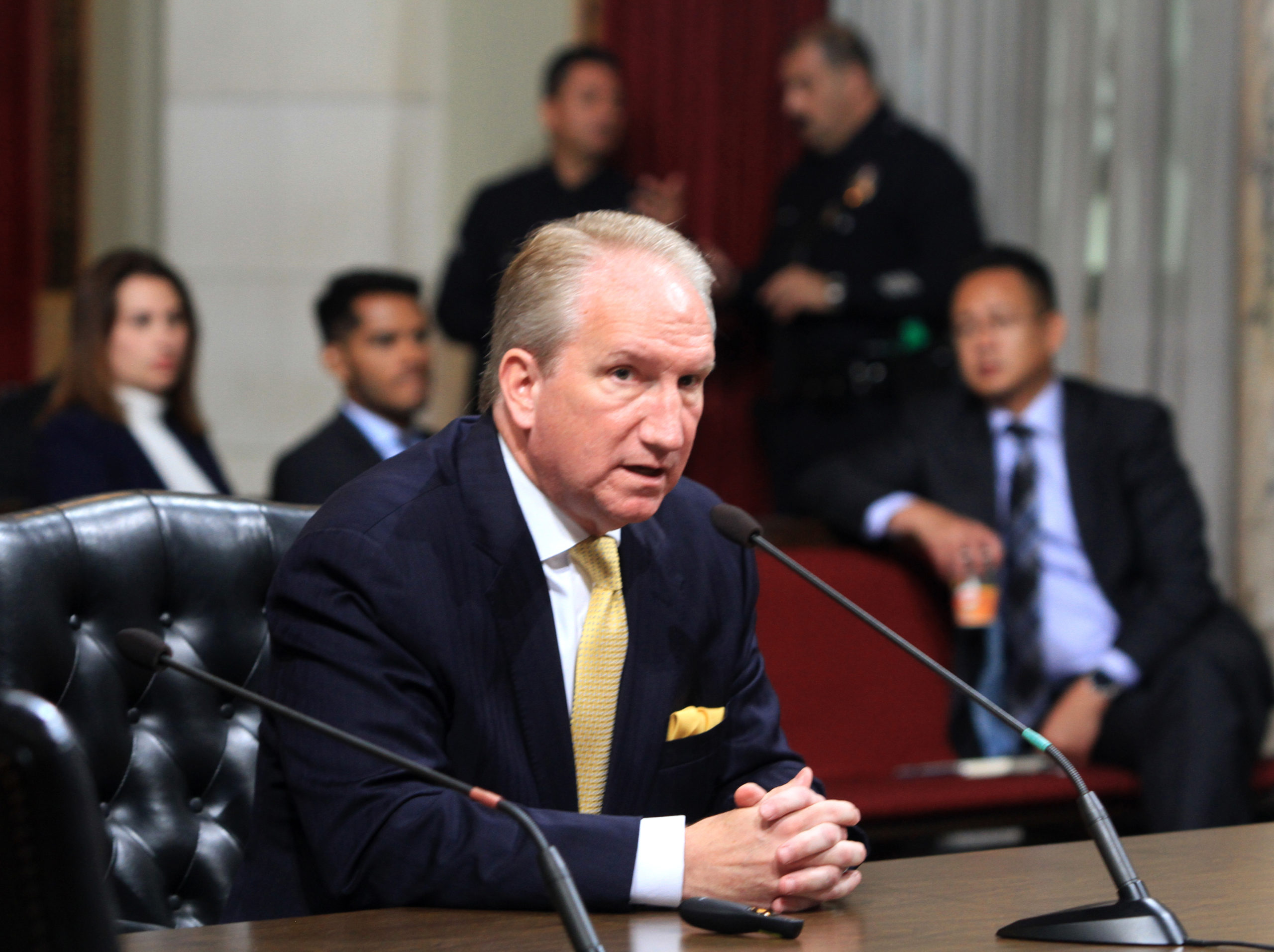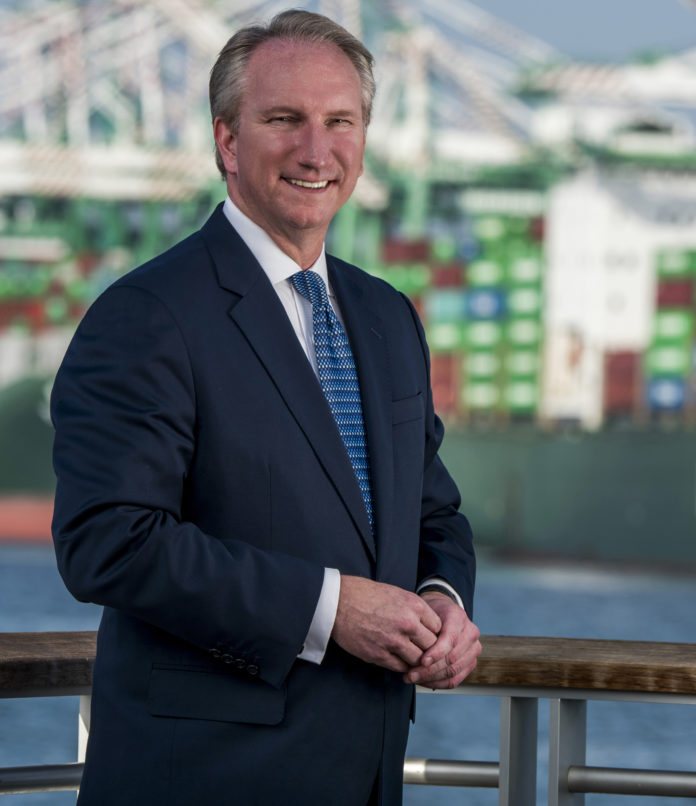Gene Seroka, the executive director of the Port of Los Angeles, picked up additional duties in March when Los Angeles Mayor Eric Garcetti named him the city’s chief logistics officer.
While maintaining his responsibilities at the port and overseeing its $1.6 billion operating budget, Seroka is also leading the effort to provide critical supplies to local hospitals caring for Covid-19 patients.
He heads Logistics Victory Los Angeles, a 20-member team of volunteers who recently secured a deal with North Carolina-based Honeywell International Inc. to procure 24 million N95 masks over a two-year period.
Seroka’s additional workload comes at a time when the nation’s busiest port is moving about 80% of the cargo volume that it normally would at this time of year as it contends with the aftermath of the trade war with China and the pandemic-related production slowdown.
Seroka sat down for a Zoom session to discuss the dual roles and his vision for both battlefronts.
How did your appointment come about as the city’s chief logistics officer?
This had come about through a conversation with our own vice president of the Harbor Commission Ed Renwick, the mayor, myself and some others. They approached me … and the first thought was that it was such an honor to be considered on how we could potentially add value to help our hospital workers in the midst of the greatest pandemic in a hundred years and what we could do to help those who were suffering through Covid-19.
Did you have any reservations about the role?
No. When the mayor of Los Angeles calls on you, you answer, and if he shows the belief in you, that gives you the energy, the power and the intestinal fortitude to see the job through.
Logistics Victory Los Angeles secured 24 million N95 masks. How did that deal come about?
We put together a small team of volunteers based down here at the Port of Los Angeles, and we began to examine the medical supply chain and the (personal protective equipment) market. And we saw a number of middle people who were acting as brokers that said that they could find this equipment. We were a bit skeptical. The prices were very high, and the commitments were few and far between. In fact, in looking at certain products, we had put in three, four or five orders and came up empty. … We had chased, at that point, maybe 600 or 700 leads.
Our own Avin Sharma, who works as the director of labor relations and workforce development, had a contact that put us in direct communication with Honeywell. And after a lightning-quick series of discussions, we were able to put together an agreement … for 24 million N95 masks that were NIOSH approved. …We had a fixed production schedule over the 24 months. In the month of May, we would receive 100,000 masks; in the month of June coming up here soon, we’ll receive 200,000 masks; and then we’ll ramp up very quickly. In the month of November, we’ll peak at 1.2 million masks per month through the end of the contract. … And we got a very good price, better than anyone else has gotten to date. … There is no markup; there is no margin. We’re giving this product to the hospitals at the cost that we paid.
How much of your time do you devote to Logistics Victory Los Angeles?
They are two full-time jobs, to be honest. So, the hours are long, the dedication is necessary, and you’re moving pretty fast all the time. We meet via Zoom at least three times a week. And the core team I put together of Avin Sharma, David Libatique (deputy executive director of stakeholder engagement) and Erica Calhoun (senior administrator), we meet multiple times a day.
How are we preparing for the next flu season and the possible Covid-19 rebound? Do you see your role extending past 2020?
I see a real need in the medical community and the supply chain for a stockpile of high-volume necessities. … We still remain in a triage phase today of trying to get enough equipment to our frontline hospitals. Over the coming months, and maybe calendar quarters, we’ll come up for air at some point as we curb this virus and hopefully lead toward eradication of the illness. And at that point, we’re going to make decisions on how we replenish this stock as a community, across Southern California — what safety stock levels need to look like, what types of products have to be in what quantities at the hospital’s ready inventory levels, and then ultimately, what is the medical supply chain going to look like and what does it need?
What’s next on your list for Logistics Victory Los Angeles?
This program was set up not to answer all of the inventory needs of every hospital in Southern California, but it was very targeted. It was a city of Los Angeles service based on us volunteers, working with hospitals, both public and private. But as our mayor said, this virus knows no boundaries. So, if we have hospitals who may be of small or midsize that don’t have the buying power or are out of a specific product that we may have, we leap into action. And our design is to plug holes or fill gaps, but broadly speaking, now we’ve got folks that are really looking at harnessing the power of partnership and being able to do consortium buy concepts, banding together and buying more product at a better price point with a higher level of probability for delivery, moving ourselves up in the queue or the priority list because we built so much buying power.
What keeps you up at night when it comes to the Port of Los Angeles?
Phil Washington, who is the head of Los Angeles Metro, once said to a question like this, ‘I sleep very well at night, but there are a number of things that I work on diligently, and there’s various risk assessments.’ The supply chain has been hit with two really difficult shocks to the system. One is the ill-advised tariff policies out of Washington with respect to our trade with China. And the second has been basically Covid-19 response with an economic shutdown in the world’s largest economy. Right now, the Port of Los Angeles is moving about 80% of the volume that it normally would for this time of year. And given that almost 40 million Americans are out of work, I’ll take that for right now.
The Port of L.A. is competing for cargo with other ports — is everybody struggling right now?
Everybody is struggling a little bit, to varying degrees. I think you might see a little bit more impact here in Los Angeles because of our proximity to Asia. And in our book of business, China represents a much higher percentage than many ports around the nation, especially those on the East and Gulf Coast. So, the impacts from this two-level shock seem to be hitting us harder.

How important is it for the Port of L.A. to maintain the “busiest port” designation?
I think it’s the most important thing because more cargo coming through this port will mean more American jobs. It also allows us, if business is strong, to have a leadership voice in environmental strategy and in the work that we do with all types of labor, both organized and those who may not be. It helps us put the worker first because we hold that pole position.
What’s one thing that most people get wrong about your job?
I think probably the best way to put it, as some have said, if you see one port, you’ve seen one port. But if you try to compare Los Angeles to “Port B” or “Port C,” it doesn’t do that port or our port justice. I think each port has its own unique particulars. It has its own strong workforce, its own strong community, and what value comes from that location. … And I think the other thing on that very subject, which is also really important to us, is that every decision we make is important to someone — it could be a local resident, it could be a worker, it could be somebody who ships cargo through here, to an elected official ― everything we do impacts someone. And that’s why we have to be so sensitive and work with a wide-reaching stakeholder group.
How do you see automation at the Port and potential job losses playing out?
It’s probably one of the toughest questions we face in America today. … The American worker is wondering if they’re going to be left behind, if they haven’t been already. So, I think a national conversation about what the future of work is is a must. And it has to be the highest priority. Here locally, we’ve been doing that. It’s been difficult because of contractual relationships that exist today in and around our industry of transportation, and not just port work, but broadly that ecosystem is very difficult.
We have done a number of independent studies predating my time here, and then after I’ve come to the Port of Los Angeles six years ago, and what I can tell you is the studies all intersect at one place: There will be more cargo here, save any calamity or any way of us shooting ourselves in the foot through something outside of normal day-to-day work. But more cargo means more longshore jobs, means more truck jobs. How many, I don’t know, that’s what the finer points have got to be in this discussion.
What would you tell the young Gene Seroka who just graduated from University of New Orleans with an MBA?
I’d say a couple of things: Keep a very open mind, but more importantly, stay visible, stay mobile and stay durable. Jobs aren’t necessarily made in your hometown. You’re not going to grow up, go to school, live, you know, do whatever you want to do, work and retire in your hometown. You’ve got to be mobile and create as much opportunity as you can for yourself. Stay visible — in this day and age, a lot of us, myself included, we love texting. We love getting messages out there real quick. … It is a relationship-based business whether you’re in banking, transportation or journalism. And lastly, durability I think is important. The only way you’re judged is how you get up, not how you’re knocked down. You’re going to take some tough days. You’re going to have some great days. But stay durable. You can’t be too fragile where the criticism really impacts the work output, but you also have to be sensitive to the fact that when people do give you advice, you should listen for those who came before you.

